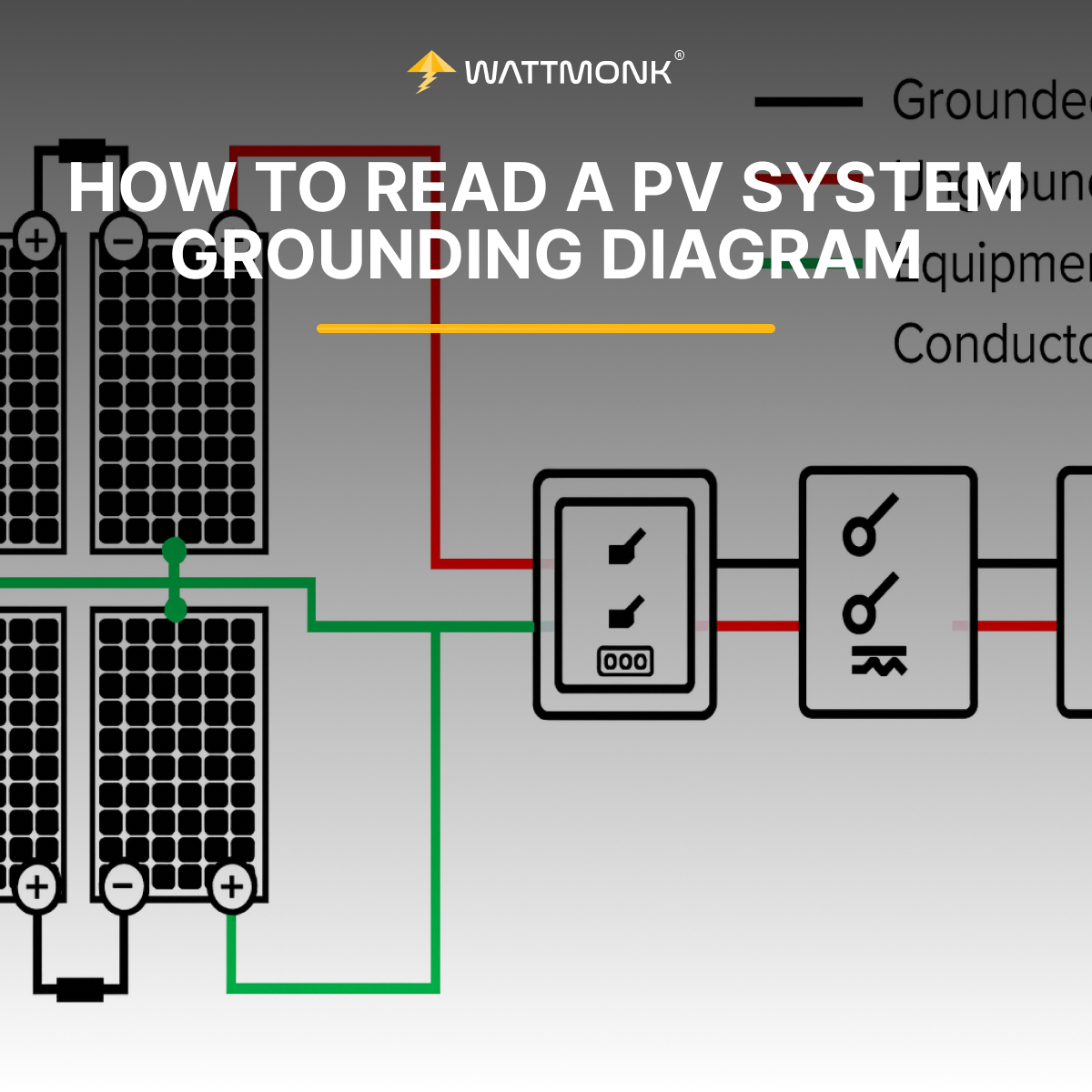A 2024 SEIA report found that over 1 in 5 solar inspection failures are linked to grounding issues many of which start with a misunderstood or overlooked PV system grounding diagram.
For installers and designers, reading these diagrams shouldn’t be a guessing game. They’re critical for safety, NEC compliance, and smooth inspections — yet often skipped or rushed through.
This guide breaks down how to read a PV system grounding diagram in under 10 minutes. Whether you’re reviewing a plan set or prepping for an AHJ inspection, these tips will help you avoid costly mistakes.
What Is a PV System Grounding Diagram?
A PV system grounding diagram is a dedicated part of the solar plan set that shows how all metallic parts of the system are electrically connected to the earth or a grounding point. Its purpose is straightforward: to ensure safety by preventing shock hazards and reducing the risk of equipment damage during a fault or lightning strike.
But beyond safety, grounding is a code-mandated design element. These diagrams are required by local Authorities Having Jurisdiction (AHJs), utilities, and financiers during plan reviews, inspections, and approvals.
You’ll typically find the grounding diagram near or within the electrical sheets of your plan set. It highlights:
Equipment Grounding Conductors (EGCs) connecting racking, panels, and enclosures
Grounding Electrode Conductors (GECs) leading to the main service ground or UFER
Bonding jumpers across system components to ensure continuity
Symbols, wire sizes, and connection points that detail how grounding is implemented
NEC PV System Grounding Diagram Rules You Must Know (2023–2025 Updates)
Grounding in PV systems isn’t just best practice — it’s a strict code requirement under the National Electrical Code (NEC). Whether you’re designing or installing, understanding the latest grounding rules is critical for passing inspections and avoiding rework.
Here are the key NEC articles and updates relevant for PV grounding as of 2025:
1. Article 250 – Grounding and Bonding (General Rules)
Governs grounding electrode conductors (GEC) and equipment grounding conductors (EGC)
Requires all metallic parts likely to become energized to be bonded and connected to ground
Specifies conductor sizing (Table 250.66) and installation methods (e.g., continuous runs, protection from physical damage)
2. Article 690.43 – Equipment Grounding
All exposed metal parts of module frames, mounting structures, enclosures, and other equipment must be grounded
Bonding jumpers must ensure electrical continuity across components
3. Article 690.45 – Size of EGCs in PV Systems
Allows use of Table 250.122 to determine minimum EGC size based on overcurrent device rating
Copper is preferred, but aluminum is allowed under specific conditions
4. Article 690.47 – Grounding Electrode System
Clarifies when and how a separate grounding electrode system is required (e.g., for ungrounded PV systems or microinverters)
Requires direct connection to the building’s grounding system unless exempted
Key Elements to Spot in Under 10 Minutes
Once you open a PV system grounding diagram, your goal is to quickly verify that the grounding is complete, code-compliant, and clearly labeled. Here’s how to do:
1. Understand the Grounding Symbols and Legend
Start by checking the diagram legend. Look for standard grounding symbols:
Ground rod
Bonding jumper
Equipment grounding conductor (EGC)
Grounding electrode conductor (GEC)
Lug or clamp connections
Installers often skip this step, but symbols vary by drafter or firm. Always match what’s on the legend with what appears in the diagram.
2. Trace the GEC Path
Look for the grounding electrode conductor — it should run from the inverter, combiner box, or disconnect all the way to:
The main service panel, or
A UFER ground or ground rod
Check that the conductor size (often #6 AWG copper) and path comply with NEC 250.64 — especially if there are splices or bends.
3. Verify Equipment Bonding
Ensure metal racking, module frames, and enclosures are:
Bonded with EGCs
Connected using UL-listed grounding lugs or WEEBs
Continuous across the array (no isolated metal parts)
Inspectors often flag bonding jumpers that are missing between rows or not torqued to spec.
4. Look for Ground Rods and Connection Details
Confirm:
Ground rod location is clearly marked
At least 6 feet away from other rods or structures
Proper connection method (e.g., acorn clamp, irreversible crimp)
Double-check if a separate ground is needed for a detached structure.
5. Review Notes and Callouts
Most grounding diagrams include textual notes that clarify:
Conductor types (e.g., bare copper, THWN-2)
Torque specs and lug requirements
AHJ-specific grounding demands
These notes often address what can’t be shown clearly in the line diagram, so don’t ignore them.
From Symbols to Safety: Decoding a PV System Grounding Diagram
Interpreting a PV system grounding diagram isn’t just about following lines — it’s about understanding how those lines translate into real-world safety and compliance. Here’s how to connect what’s on paper to what happens in the field.
1. Each Symbol Represents a Safety Action
Ground rods aren’t just squiggles — they’re your system’s path to safely dissipate fault current.
Bonding jumpers ensure every piece of metal is at the same electrical potential, preventing arcing.
EGCs and GECs maintain continuity between equipment and earth — essential for breaker operation and personal safety.
2. Connection Points = Critical Risk Zones
Every point where grounding conductors connect — inverter chassis, disconnect enclosures, combiner boxes — must be:
Mechanically secure
Free from corrosion
Installed with proper lugs or clamps (UL-listed)
Diagrams often mark these points with notes or annotations. Skipping over them in the field leads to common grounding failures.
3. Conductor Sizing Isn’t Just a Code Detail
The size of your GEC or EGC affects its ability to carry fault current safely. Oversizing isn’t a problem — but undersizing definitely is.
Use the diagram to:
Cross-check conductor sizes against NEC tables
Verify if any derating or parallel conductor runs are in play
Flag inconsistencies before installation
4. Pay Attention to Local Variations
While NEC is national, local AHJs often interpret grounding rules differently. Wattmonk’s plans are jurisdiction-aware — so if your county requires a separate ground for detached garages, or only accepts CAD-welded connections, it’ll be in the diagram and notes.
Reading PV System Grounding Diagrams Shouldn’t Be the Bottleneck
Grounding might not be the flashiest part of a solar install, but it’s one of the most critical — and most scrutinized. A single oversight in your PV system grounding diagram can mean delays, red tags, or even safety risks.
The good news? You don’t need to be a code expert to read these diagrams confidently. Once you know what to look for — grounding paths, bonding points, conductor sizes, NEC references — it becomes second nature.
At Wattmonk, we’ve built our solar plan set service around helping installers like you stay compliant, pass inspections faster, and reduce rework. Every grounding diagram we deliver is checked against the latest NEC codes and local AHJ rules, so you can focus on getting systems energized, not stuck in permitting.


